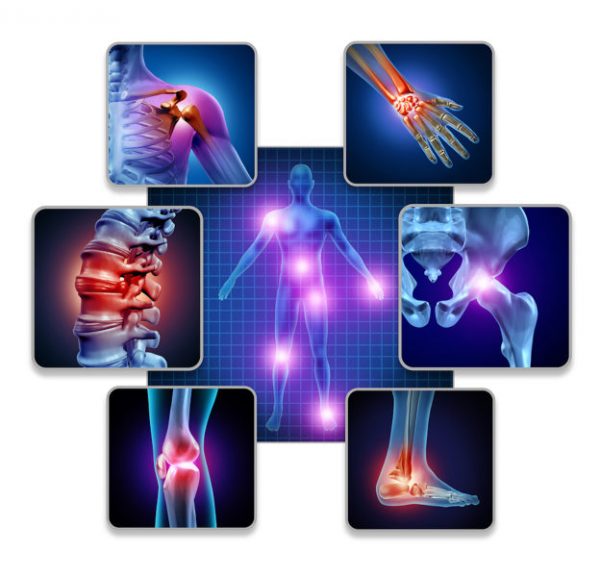I recently had a patient diagnosed with rheumatoid arthritis (RA). She had joint pain and swelling in the fingers, wrists, elbows, shoulders, knees, ankles; everywhere!
When she came to see me, we did a comprehensive digestive stool analysis. This is a stool test that looks at a lot of things. This includes markers of digestion, absorption, sensitivities, inflammation and immune function.
The results of the test showed she was grossly inflamed, with a very high level of increased intestinal permeability – or leaky gut. It turns out she was sensitive to a lot of the foods she was eating, especially gluten.
The food particles were getting through her leaky gut into her bloodstream, and settling in the joints. This put the immune response into overdrive, attacking her joints to fight off what the body saw as foreign matter.
Just the simple act of removing gluten from her diet for a month improved her symptoms by about 50%.
The Gut-Joint Axis
This is something called the “gut-joint axis.” Basically, it’s a complex interaction between food sensitivities, gut bacteria and leaky gut syndrome that triggers flare-ups in RA and other joint disorders, including osteoarthritis and psoriatic arthritis.
First of all, the microbes in your gut play an extremely large role in chronic, inflammation.
For example, people with osteoarthritis have an overabundance of at least six particular microbial species in their gut. This includes two different types of clostridia and four types of bacillus that appear to be closely associated with the pain and severity of arthritis in the knees and hips.
In addition to that, the pain is compounded when undigested food particles get into your bloodstream due to intestinal permeability.
This is why so many of the foods you eat can have such a profound effect on joint pain and intensity.
In part, you can blame it on all of the sugars, refined carbs, artificial sweeteners, red meat, dairy products, gluten, vegetable oils, fried and processed foods that wreak havoc on your gut microbiota. All of these foods can cause joint flare-ups and excruciating pain after they are eaten.
Soothe Your Gut to Soothe Your Joints
Rebuilding the health of your gut microbiota is your first step when it comes to joint health. And it isn’t nearly as hard as you might think it might be. It just requires a little time, patience and a few diet modifications on your part.
Remove allergens like milk and wheat from your diet. Humans weren’t meant to drink cow’s milk. And many arthritis patients find that drinking milk makes their symptoms worse. As far as wheat and other grains (such as barley and rye) are concerned, they contain gluten. Gluten triggers inflammation and alters the healthy balance of flora in your digestive tract.
Avoid eating processed foods, unhealthy fats and too much meat. This includes sugary, salty, fatty, fried foods and most products that come in a box or package. When it comes to meat, poultry and fish, stick with those that are grass-fed, pasture-raised and wild-caught, and keep them to a maximum of about 15% of your overall diet.
Fill 85% of your plate with vegetables and other plant-based foods. The enzymes and antioxidants in organic fruits, vegetables and beans promote the growth of healthy bacteria. In fact, people who eat the most of these foods have a much healthier diversity of gut microbiota. Most of my arthritis patients experience significant improvement in pain levels when adopting a more plant-based diet.
Eat more fermented foods. They’re a great source of natural probiotics that feed your gut. Kimchi, miso, natto, kefir, tempeh and sauerkraut are all fermented foods. Or you can simply add a probiotic to your daily regimen. Look for a formula that contains a prebiotic along with lactobacillus, bifidobacteria and other strains of healthy bacteria. The higher the colony count, and the more live strains involved, the better off you’ll be. Just make sure to take it daily with food.
These changes alone can have a profound impact on your joint health. And when you combine these tips with a regular, physician-approved exercise program and other healthy choices, you can vastly improve your mobility and reduce pain levels so you can remain independent for years to come.
SOURCES:
Matei DE, Menon M, Alber DG, Smith AM, Nedjat-Shokouhi B, Fasano A, Magill L, Duhlin A, Bitoun S, Gleizes A, Hacein-Bey-Abina S, Manson JJ, Rosser EC; ABIRISK Consortium, Klein N, Blair PA, Mauri C. Intestinal barrier dysfunction plays an integral role in arthritis pathology and can be targeted to ameliorate disease. Med (N Y). 2021 Jul 9;2(7):864-883.e9.
Binder HJ, O’Brien WM, Spiro HM, Hollingsworth JW. Gluten and the Small Intestine in Rheumatoid Arthritis. JAMA. 1966;195(10):857–858.
Bruzzese V, Scolieri P, Pepe J. Efficacy of gluten-free diet in patients with rheumatoid arthritis. Reumatismo. 2021 Jan 18;72(4):213-217.
Hao X, Shang X, Liu J, Chi R, Zhang J, Xu T. The gut microbiota in osteoarthritis: where do we stand and what can we do? Arthritis Res Ther. 2021 Jan 27;23(1):42.
Myers B, Brownstone N, Reddy V, Chan S, Thibodeaux Q, Truong A, Bhutani T, Chang HW, Liao W. The gut microbiome in psoriasis and psoriatic arthritis. Best Pract Res Clin Rheumatol. 2019 Dec;33(6):101494.
Boer CG, Radjabzadeh D, Uitterlinden AG, Kraaij R, vanMeurs JB. The role of the gut microbiome in osteoarthritis and joint pain. Osteoarthritis and Cartilage. 2017 Volume 25 Supplement 1, Page S10.
Clinton CM, O’Brien S, Law J, Renier CM, Wendt MR. Whole-foods, plant-based diet alleviates the symptoms of osteoarthritis. Arthritis. 2015:708152.



